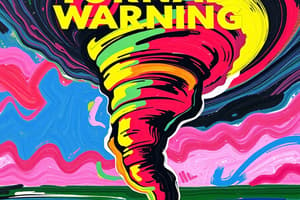Podcast
Questions and Answers
A tornado watch is issued when a tornado is already spotted.
A tornado watch is issued when a tornado is already spotted.
False (B)
Tornadoes are only possible in certain areas and during specific seasons.
Tornadoes are only possible in certain areas and during specific seasons.
False (B)
Tornado watches are typically issued at least 10 hours in advance of anticipated risky weather.
Tornado watches are typically issued at least 10 hours in advance of anticipated risky weather.
False (B)
The National Weather Service (NWS) recommends ignoring severe weather plans when a tornado watch is issued.
The National Weather Service (NWS) recommends ignoring severe weather plans when a tornado watch is issued.
Tornado warnings are issued when the conditions are favorable for the development of tornadoes.
Tornado warnings are issued when the conditions are favorable for the development of tornadoes.
A tornado watch can last for up to 24 hours.
A tornado watch can last for up to 24 hours.
A tornado warning is issued when a tornado is possible in the area.
A tornado warning is issued when a tornado is possible in the area.
A tornado watch is more severe than a tornado warning.
A tornado watch is more severe than a tornado warning.
When a tornado warning is issued, you should wait for further instructions before taking action.
When a tornado warning is issued, you should wait for further instructions before taking action.
Tornadoes can cause significant damage and pose a serious threat to people's safety.
Tornadoes can cause significant damage and pose a serious threat to people's safety.
A tornado warning means that a tornado could occur in the future but has not been sighted.
A tornado warning means that a tornado could occur in the future but has not been sighted.
Understanding the differences between tornado watches and warnings is not important for ensuring safety during potential tornado events.
Understanding the differences between tornado watches and warnings is not important for ensuring safety during potential tornado events.
Flashcards are hidden until you start studying
Study Notes
Tornadoes and Their Warning Systems
Understanding the Differences and Importance of Tornado Watches and Warnings
Tornadoes are violent, destructive storms that can occur at any time of the year and in any location, although they are more common in certain areas and during specific seasons. These storms can swiftly cause immense damage, and timely warnings are crucial for ensuring public safety. In the United States, the National Weather Service (NWS) issues two types of alerts related to tornadoes: tornado watches and tornado warnings. Understanding the differences between these two alerts and their significance can help you prepare for potential tornado situations and keep yourself and your loved ones safe.
What is a Tornado Watch?
A tornado watch is an alert issued by the National Weather Service (NWS) when the conditions are favorable for the development of tornadoes. This means that the atmosphere is primed for thunderstorms capable of producing tornadoes. Tornado watches are typically issued at least an hour in advance of anticipated risky weather and can last for up to eight hours.
When a tornado watch is issued, the NWS recommends staying prepared and being ready to act if a tornado is spotted and a warning is issued. This is a time to review your severe weather plans, find shelter, and make sure you have access to any necessary emergency supplies.
What is a Tornado Warning?
A tornado warning is a more severe alert issued by the NWS when a tornado has been sighted or indicated by weather radar. This means that a tornado is imminent and is either currently happening or about to happen in your area. When a tornado warning is issued, the NWS advises taking immediate action, which includes moving to the lowest floor of a sturdy building and avoiding windows.
If you are in a car or mobile home, find the closest substantial shelter you can reach. During a tornado warning, it is essential to take shelter immediately and follow the advice of local authorities.
Is a Tornado Warning or Watch More Dangerous?
A tornado warning is more severe than a watch, as it indicates that a tornado has been spotted or is imminent. A tornado watch, on the other hand, means that conditions are favorable for tornadoes, but one has not been sighted or indicated by radar.
In the words of NWS Albuquerque, "If there's a watch, it's like we have the ingredients to make tacos, but if there's a warning we are having the tacos right now".
Importance of Tornado Alerts and Preparedness
Tornadoes can cause significant damage and pose a serious threat to people's safety. Therefore, it is essential to pay attention to tornado alerts and take appropriate actions when necessary. Stay informed about your local weather conditions and be prepared to seek shelter or take other protective measures when a tornado warning is issued.
Additionally, understanding the differences between tornado watches and warnings can help you react appropriately and ensure your safety during potential tornado events.
Studying That Suits You
Use AI to generate personalized quizzes and flashcards to suit your learning preferences.




